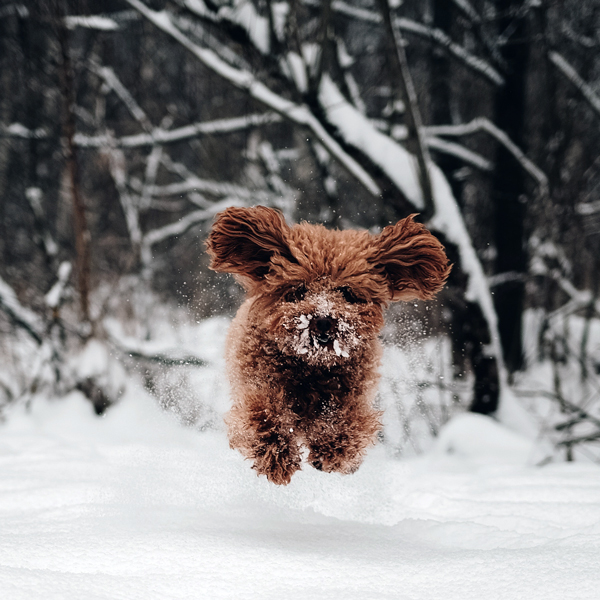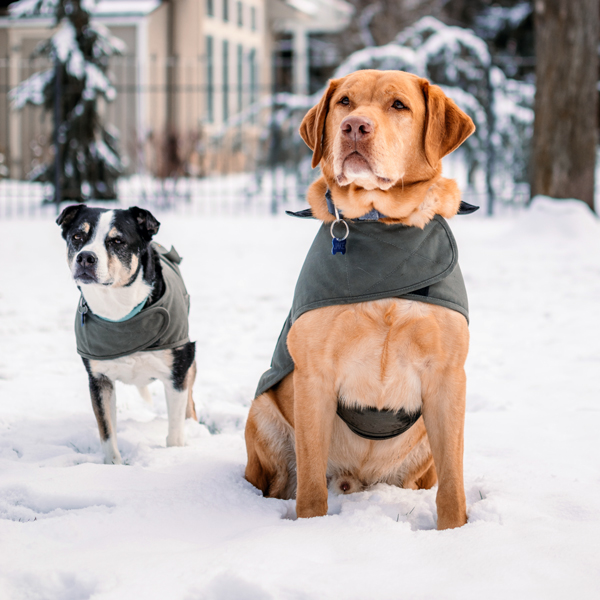Pet Safety in Colder Months

When the temps start to drop, you’re not the only one who notices. Unlike you, your dog doesn’t have the benefit of pulling warmer layers out of the closet. While some breeds love to romp and play outside in the snow and rain, others prefer to huddle up inside. Regardless of what your pup’s preference is, remember that exposure to winter’s cold air and chilly rain, sleet, and snow can lead to chapped paws and dry, itchy skin. Furthermore, exposure to toxic holiday foods and plants, antifreeze, and ice-melting chemicals can be downright dangerous. Fortunately, there are a few easy steps you can take to both help your dog acclimate to the weather change and stay safe from potential hazards.
First, Know The Dangers:
Watch out for these risky hazards that are unique to the winter months –
Hypothermia: If it’s too cold for you, it’s likely too cold for your dog. When left outside in the cold, pets can freeze and become disoriented and lost, injured or even killed. The same is true for being left in your car—cars become like ovens in the summer, and like freezers in the winter.
Ice. Whether a slippery path or thin ice on lakes and ponds, ice can present a danger to dogs and puppies who aren’t aware of it. Be mindful of slick walkways to prevent slips and muscle tears and strains, and never let your dog wander onto frozen bodies of water, as hypothermia and drowning can happen quickly.
Chemicals: Snow-melt agents are harsh and lead to dry, cracked, and bleeding paws—and can be harmful if ingested if your dog attempts to lick it off. Likewise, even a small amount of antifreeze can be fatal. Make sure to use pet-friendly melt, wipe their paws down upon returning home, and keep all chemicals locked away and out of reach.
Arthritis: If your dog already experiences arthritis, cold weather can make the symptoms worse. Keep them warm and dry, and perhaps talk to your vet about approved medications to help them manage pain.
Winter Holiday Celebrations: While many of us look forward to annual traditions, many of them don’t serve our pets. Be mindful of unsafe foods, attended candles, and poisonous seasonal plants (like holly, mistletoe, and poinsettia). Make sure your Christmas tree is stable and prevent your pup from ingesting pine needles or water from the tree’s base.
Take Action
Wellness: It’s a good idea to have your pet checked by a vet at least once a year, and the winter is a great time to make sure he or she starts the cold season happy and healthy.

Grooming: Don’t over bathe your dog during the winter months, as this can strip essential moisturizing oils from their skin and lead to itching and flaking. Likewise, avoid shaving them down as longer coats provide more warmth. If your pup has long hair, consider only trimming the length to minimize clinging ice balls.
Stay Warm & Protected: While some dogs enjoy being in the cold longer, it’s incorrect to assume pets can tolerate cold better than humans. If it’s too cold for you, it’s too cold for them. Make sure you know their limits—your vet can help guide you on what is appropriate for your breed, consider providing a high-collared coat for outdoor treks, and make sure to wipe them down and provide a warm, draft-free spot in your home when you come back in. Protect those paws by removing snowballs, checking for cracks and bleeding, and perhaps protecting them with a layer of petroleum jelly or booties.
Collar & Chip: Dogs can easily become disoriented and lost in the cold. Besides the effect of hypothermia, cold and snow make it difficult for dogs to pick up recognizable scents that help lead them home. Make sure they are chipped and collared in the event they lose their way.
Winter wellness: Has your pet had his/her preventive care exam (wellness exam) yet? Cold weather may worsen some medical conditions such as arthritis. Your pet should be examined by a veterinarian at least once a year, and it’s as good a time as any to get him/her checked out to make sure (s)he is ready and as healthy as possible for cold weather.
Provide choices: Just like you, pets prefer comfortable sleeping places and may change their location based on their need for more or less warmth. Give them some safe options to allow them to vary their sleeping place to adjust to their needs.
Stay inside. Cats and dogs should be kept inside during cold weather. It’s a common belief that dogs and cats are more resistant than people to cold weather because of their fur, but it’s untrue. Like people, cats and dogs are susceptible to frostbite and hypothermia and should be kept inside. Longer-haired and thick-coated dog breeds, such as huskies and other dogs bred for colder climates, are more tolerant of cold weather; but no pet should be left outside for long periods in below-freezing weather.
Collar and chip: Many pets become lost in winter because snow and ice can hide recognizable scents that might normally help your pet find his/her way back home. Make sure your pet has a well-fitting collar with up-to-date identification and contact information. A microchip is a more permanent means of identification, but it’s critical that you keep the registration up to date.

Be prepared: If you live in a region prone to blizzards, high snowfall counts, and power outages, be prepared. Make sure you have enough food, water and pet medications to get through at least five days.
Recognize problems: If your pet is limping, seems anxious, is shivering, whining or slows down or stops moving, seems weak, or starts looking for warm places to burrow, get them back inside quickly—these are signs of hypothermia. Unfortunately, frostbite is harder to detect, and may not be fully recognized until a few days after the fact. If you suspect your pet has hypothermia or frostbite, consult your veterinarian immediately.
